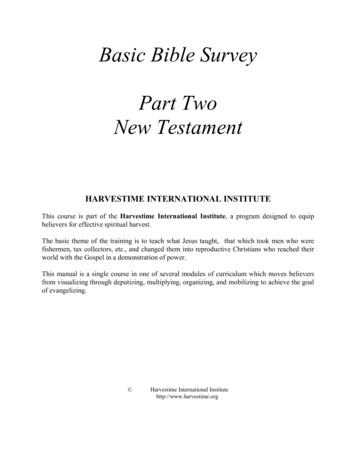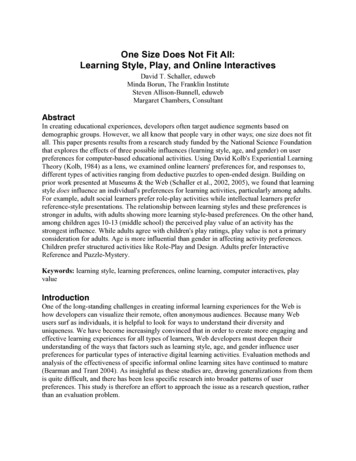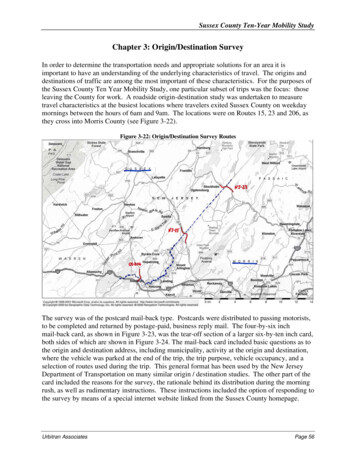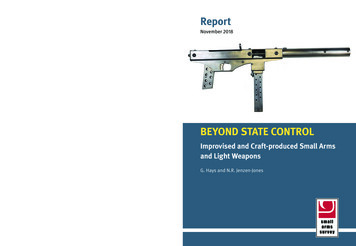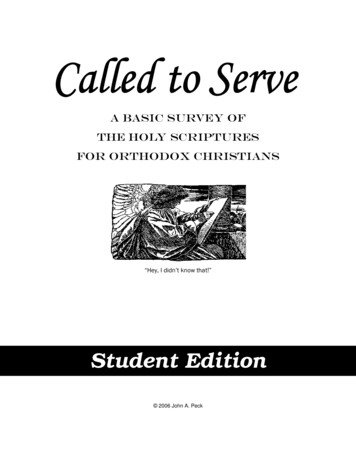
Transcription
A Basic Survey ofthe Holy ScripturesFor Orthodox Christians“Hey, I didn’t know that!”Student Edition 2006 John A. Peck1
Called To Serve: A Basic Survey Course of the Holy ScripturesFirst edition: 2002 John A. PeckSecond edition 2006 John A. PeckAll rights reserved.No part of this book may be copied or reproducedwithout the permission of the author.2
CALLED TO SERVETable of ContentsLesson 1: About the Holy Scriptures . 5Lesson 2: About the Two Testaments . 10Lesson 3: The Nature of the Holy Scriptures . 13Lesson 4: Books of the Old Testament. . 18Lesson 5: Books of the New Testament . 22Lesson 6: Old Testament Persons: Part 1 . 24Lesson 7: Old Testament Persons: Part 2 . 26Lesson 8: About the Altar and the Tabernacle . 28Lesson 9: About the Temple . 31Lesson 10: About the Jewish Feast Days . 34Lesson 11: Old Testament Geography . 37Lesson 12: New Testament Geography . 41Lesson 13: Life of Jesus Christ: Part 1 . 45Lesson 14: Life of Jesus Christ: Part 2 . 47Lesson 15: Life of Jesus Christ: Part 3 . 50Lesson 16: About the Twelve Apostles . 53Lesson 17: About the Christian Life . 56Lesson 18: The Life of St. Paul . 58Lesson 19: The First Century Church . 60Lesson 20: The Bible Today . 65Feedback form: . 68Additional books from INTERIOR STRENGTH PRESS . 693
4
testamental period” because we see the OldTestament as not just a set of writings, but aliving covenant which remained in effect untilthe New Testament fulfilled it.Lesson OneAbout the Holy ScripturesThe Bible is the written witness of God’srevelation to His people. But it is more than justa record of God’s word. You can read the recordof an event, but simply reading this record doesnot permit you to actually participate in theevent. I can read about the Civil War, but thatdoes not mean I actually experience orparticipate in it, even if I go to Civil Warreenactments. I can only experience what itmay have been like, but the actual event isbeyond my experience.Objectives of this lessonAt the end of this lesson, you should know: How many books in the Orthodox Bible; How many people actually wrote the Bible; How many years it took to write the Bible; The three designations of the term “Word of God”; The primary difference between the Old and NewTestaments. Some early versions of the Bible in English The Common version of the western Roman Empire Some modern versions of the Bible in EnglishThe Holy Scriptures, however, offer us directparticipation in the life of God, because theyare His message to us (not just those in thepast), and present to us His truth about who weare, and Who He is. We get a chance to experience the same God, the same vision that theProphets and Apostles did.What is the Bible?The book which we call “The Bible” is actually alibrary of books. The word “Bible” is actuallyfrom the Greek word biblios (βιβλιοσ) whichsimply means the “book.”The Word of GodThere are a total of 76 books in the OrthodoxCanon of Scripture (that is, the Orthodox Bible). 49 in the Old Testament, 27 in the New Testament.The phrase “Word of God” is variously usedtoday, especially among heterodox Christians,and especially in reference to the HolyScriptures, and sometimes to the expositorypreaching of the Scriptures.The Writers of the BibleYet, to the Church Fathers, the Prophets, and toOrthodox Christians, the “Word of God” meansthe Logos, the Eternal Word, Jesus Christ, Whobecame Incarnate for us, and is glorified as“one of the Holy Trinity.” The Eternal Wordcommunicates His message to us primarilythrough the Holy Scriptures. The Word is aperson, and that person is the message. Hismessage is proclaimed throughout the Old andNew Testaments, and by those of us whoendeavor to “spread the Word.”The men who wrote the Bible did so under theinspiration of God the Holy Spirit. About fiftypeople were responsible for writing the books inour Bible. We know many of them (Moses,David, Solomon, Isaiah, etc.) but some of themwe do not know. For example, we do not knowwho wrote the book of Job, or some of thePsalms.The Bible was written from about 1400 B.C. toabout 100 A.D. - a period of about 1500 years.To the Orthodox Christian, there is no “inter-Thus, for us there are three distinct, but5
interconnected, designations of the “Word ofGod.”we have so many manuscripts that go back tothe 1st and 2nd centuries, it is easy for us tocompare and see where these additions occur.The term manuscripts indicates a handwrittencopy in the language of the original.1. The God-man Jesus Christ, the EternalWord, the 2nd person of the Holy Trinity,2. The written witness to Him in the form ofprophetic and apostolic writings, that is, theHoly Scriptures, and,TranslationsWhat is today referred to as a version of theBible, is a translation. The oldest version of theOld Testament is called the Septuagint. It isfrequently abbreviated as LXX (the romannumerals for “70”) The Septuagint OldTestament is an ancient Greek version of theOld Testament, translated at the order ofPtolemy, the King of Egypt, beginning around269 B.C. It is the oldest version of the OldTestament that we have in any form or in anylanguage.3. The proclamation of Him as an invitation tofaith and life in Him.For the Orthodox Christian, the Old and NewTestaments form a unified whole of God’srevelation. That is, we do not see the OldTestament as the ‘Jewish Bible,’ and the NewTestament as the ‘Christian Bible.’ We see thatthe Old Testament prophets were receivinginstruction from, and witnessing to, the sameChrist that the New Testament apostles were.The primary difference between the two is oneof promise, and fulfillment. One may also seethat the Old Testament addressed exterior orritual holiness, while the New Testament dealswith interior or personal holiness.The LXX was the Bible used and quoted by ourLord Jesus Christ. It was used by Ss. Peter,Paul, James, John and all the Apostles and earlyChurch. It is most often quoted in the NewTestament whenever there is an Old Testamentquote. There were other Greek versions madeafter the Septuagint. These include the ones byAquila, Theodotus, and Symmachus, but noneof them were accepted as authoritative likethe Septuagint. The Septuagint was the“King James Version” of its day.Ancient Manuscripts andTranslationsNo part of the Bible currently exists in what wecall the “autograph” copy, that is, the originaldocument in the original handwriting of thewriter. What we do have is ancient manuscriptsin the original language, and ancienttranslations of the original texts.Other versions of the Bible include the LatinVulgate (meaning “common” or “vernacular”)and was in common use in the west for manycenturies. It is the official version of the RomanCatholic Church even to this day. There werealso many Syriac, Coptic, and Ethiopiantranslations of Scripture.ManuscriptsAll manuscripts are documents which werecopied by hand in the original language.Of course, there was no printing press until the16th century. Manuscripts are made fromanother original copy. Many of these werescrupulously and tediously copied. Occasionally,there were errors in the copying, but becauseYou will, from time to time hear of somethingcalled the Masoretic text, or version. Masoretictext is often abbreviated MT. It is a version ofthe Hebrew Old Testament, translated from700-1000 a.d. (yes, that’s right) by theMasorets, Jewish scholars trying to standardize6
the Old Testament Hebrew lettering and pronunciation from fragments of existing Hebrew, oraltradition, and the Septuagint.Haplography in the MTOften, they translated well known references toChrist out of the text. This is a process scholarscall haplography, or “plain writing.” It means tomake “plain” or flat something which was notplain before. In many places the Hebrew in theMasoretic text is obscure, or nonsensical. Oftenthis is because of the attempt to remove anyreference to Christ or the Church’s interpretationof Him, from the text.For example, in Psalm 40 in the Masoretic text,verse 6 says:Sacrifice and offering Thou hast not desired,but Thou hast dug out ears for me.The Septuagint, on the other hand, sayssomething very different.Sacrifice and offering Thou hast not desired,but Thou hast prepared a body for me.This is a clear reference to the bodily Incarnationof Christ, and the process of removing theChristian reference is a textbook case ofhaplography.Another example is the Masoretic version ofPsalm 22. This is a prophecy of the Crucifixion,and in verse 16, the Septuagint says-they have pierced my hands and my feet.The Masoretic text, however, has rendered itdifferently;-they have sawed off my hands and my feet.There are many more, but we will not includethem here. This is just a survey course.7English VersionsThere have been many translations of the HolyScriptures into the English language. Somehave been good and admirable works, somehave been deliberately slanted, or poorly done,or to promote a particular theology. Very fewhave included all of the books of the Septuagintin the Old Testament.They started with a translation of the Gospel ofSt. John into Anglo-Saxon by the VenerableSt. Bede in the early 700s.Alfred the Great translated portions of the Bibleinto Old English around 900 a.d. After theNorman Conquest, Norman French mixed withAnglo-Saxon to become what we now call“Middle English.”Around 1380 a.d. John Wycliffe and his fellowworkers, translated the Bible from the LatinVulgate into Middle English.In the 1520’s a.d. William Tyndale produced hisown translation of the Bible. Tyndale used theavailable Greek and Hebrew texts, as well asthe Latin Vulgate, for his translation.In 1568, in response to several roughlytranslated puritan versions of the Bible, theChurch of England produced their own version,known as the “Bishop’s Bible.”In 1611, under the appointment of King Jamesof England, 54 scholars produced a newversion, based on the earlier “Bishop’s Bible”,but also consulting other English versions, theVulgate, Greek, Hebrew, Syriac, and Germantexts (Luther’s translations, which hadconspicuously removed several books from theNew Testament!). It was published first in1611. It was subsequently republished severaltimes afterwards, with corrections, as therewere mistakes in the first versions.
Interestingly, until about 1929, the King JamesVersion of the Bible did contain the books ofthe Septuagint Old Testament!How many are in the New Testament?Modern English VersionsHow many men actually wrote the Bible?We won’t attempt to list them all here. Thereare more and more every year. Not all are ofvalue, and many have been produced andtranslated with a particular theological slantpermeating the text. It is best to avoid them.How long did it take them?What are the three designations of the term“The Word of God” generally used by OrthodoxChristians?Revised Standard Version (1952)The RSV is the version which OCA liturgicaltextual translations are made from.New American Standard Bible (1963)New International Version (1978)New King James Version (1982)New Revised Standard Version (1989)The NRSV has the dubious distinction of beingroundly condemned by Orthodox bishops inAmerica, so blatant is the deliberate theologicalerror evident in its translation.English Standard Version (2001)Which one do the fathers typically use?This is very like the original RSV, but updated.There are many other versions of the Bible inEnglish now. It is hard to keep track of them all,and they are not all translated accurately, oreven well. Be careful, then, when you read fromthe Holy Scriptures!What is the Septuagint (LXX)?Why does the Orthodox Church use theSeptuagint Old Testament?LESSON ONE REVIEWWhat does the word “Bible” mean?How many books are in the Orthodox Bible ?What is a manuscript?How many are in the Old Testament?8
What is a translation/version?What are some modern English versions?What is the Vulgate Bible?What is the Masoretic text (MT)?When was it translated?What is haplography?Give an example of haplography. Cite theChapter and verse of the Bible passages.9
Shadow & FulfillmentLesson TwoAs we look at the Old Testament, we see it as aunified Christian book; one permeated by thepresence of Christ, and in preparation forunderstanding His Incarnation, and theinstitution of the New Covenant. Far from beinga quaint, Jewish accounting of pre-Christianhappenings, the Old Testament tells usprecisely how to interpret what Christ did, said,and set forth for us for our salvation.About the Two TestamentsObjectives of this lessonAt the end of this lesson, you should know: The divisions of the Old and New Testaments How many books in each division The purposes of each group in the New TestamentThe Old TestamentThere are interesting parallels between eventhe arrangements of the books of the Old andNew Testaments.The Books of the Old Testament can be dividedinto four easy categories. Learn them!Old TestamentNew TestamentLaw5 booksLawGospelHistories18 booksHistoryHistoryWisdom7 booksWisdomLettersProphecy19 booksProphecyProphecy*4th Maccabees is sometimes included in anappendix, but is considered part of the Old Testament.Each begins with the most important revelationof God’s Truth, followed by the Histories, thenWisdom/Letters (which tell the reader how toguide their lives) , and finally, prophecy.The Books of the Law, or the Torah,Torah are the fivebooks attributed to the Prophet Moses. Theyare also called the Pentateuch,Pentateuch which is Greekfor “the Five books.” Each of the Old Testamentbooks in English has a Greek title, because theywere named when only the Septuagint wasbeing used.Even the final books have parallels. The lastbook of the Orthodox Old Testament is the bookof Daniel, which is very similar and very relatedto the Book of Revelation. Daniel was also thelast book written in the Old Testament, just asRevelation was the last book written in the NewTestament.The Histories account for much of the history ofIsrael from the period of Joshua and theentrance into Canaan around 1400 B.C. all theway to the exploits of Judas Maccabeus around170 B.C. covering a period of about 1300years.You will find that in many heterodoxOld Testaments, that Daniel is not the last book- Malachi is the final book. These are followingthe Masoretic order, placing the 12 minorprophets at the end, since they are smallerbooks. The Septuagint Old Testament hasDaniel last since it was written last, just asRevelation is in the New Testament.The Wisdom books contain much wisdom,history and prophecy, but are catalogued underthis classification because of its profoundphilosophical truth. The wisdom books havealways formed the core of liturgical worship andhymnography, for Jews and Christians alike.10
Some of the Psalms are a thousand years olderthan much classical Greek literature, yet are stillbeing sung and prayed by over a billionChristians and Jews. Much ancient poetry isknown only to a few scholars, but the Psalms areknown by over a billion Christians.The Prophecies contain much of God’s messageto the people of Israel, particularly when theywere dabbling in idol worship, or had giventhemselves over to sinful practices. They also arefilled with references to the Incarnation of JesusChrist.The New TestamentThe books of the New Testament, like the Old,fall into easily distinguishable categories.Churches in general. There are 21 total.They help guide our Christian life.14 from St. Paul (individual)7 from other Apostles (general)They tell us the problems, and conditions ofthese early Christian communities, and thesolutions which the Apostles prescribe.The Book of Prophecy is the Book of Revelation.Written by the Apostle John while in exile onPatmos in Greece, it is the last of the NewTestament books to be written. It was written toprovide clear hope for Christians still in, andsuffering in, the world.LESSON TWO REVIEWGospel4 booksHistory1 bookWhat are the divisions of the Old Testament?Include the number of books in each divisionLetters21 booksProphecy1 bookThe books of the Gospel are the account of thelife, teaching, suffering, death, and resurrectionof our Lord Jesus Christ.There is one Gospel - the Gospel of our LordJesus Christ. There are four books recountingthat Gospel, and we call them the Gospel books.The official title of each is “The Gospel accordingto Matthew, Mark, Luke, John” indicating thatthey are not writing a new Gospel, but onlyrecording their accounting of the one Gospel.They give us Jesus’ actions, word, and doctrines.They were written so that we may believe inChrist (John 20:31).How long a time is covered by the Old Testament books of History?The Book of History of the apostolic Church istold in the Acts of the Apostles. It actually is thesecond part of St. Luke’s Gospel, and picks upwhere the Gospel leaves off.The Letters,Letters or Epistles, are letters written bycertain Apostles to individual Churches, or to11Give the divisions of the New Testament booksand the number of books in each.
Briefly tell the purpose of the GospelsWhat is the purpose of the book of Acts?What is the purpose of the Letters?What is the purpose of Revelation?12
century), and the protestant churches still haveno established authority or document whichdescribes the canon they accept.Lesson ThreeThe Nature of Holy ScripturesThe Old Testament accepted as authoritative bythe Orthodox Church is the Septuagint version.It is abbreviated LXX (roman numerals for “theSeventy”). The Septuagint is the oldestsurviving version of the Old Testament inexistence. It was used by our Lord Jesus Christ,and quoted by the Apostles throughout the NewTestament. As the oldest version, 800-1000years older than the Masoretic Hebrew text, itprovides us with the text closest to the originalwritings of any other version.Objectives of this lessonAt the end of this lesson, you should know: The council which determined the canon of Scripture aswe have it today, and the date of that council. The three criteria for Scriptural books Some books which did not make it into the canon About the spiritual sense of Scripture The four senses of Biblical interpretation Some specific examples of each kindWhich came first, the Bibleor the Church?The Orthodox Church, as the one, true Body ofChrist, used three criteria to determine whichbooks would be accepted as the NewTestament. These criteria were that the book inquestion had to be;This is self-evident to anyone who actuallyreads the Bible, as it contains the earlyhappenings of the Apostolic Church. The living,breathing, worshipping community which wentforth to the four corners of the earth did nothave a “Bible” as we have it. They did haveaccess to the Old Testament, but theyproclaimed Christ as the Savior, and did notpass out Bible tracts. To truly understand theHoly Scriptures, to accurately interpret the Wordof God to the human heart and mind, one mustrecognize that the Bible is a liturgicaldocument. That is, it is properly understoodonly within the context of the living communityof worshippers - the Church.1 Apostolic in its origin,2 Salvific in its message,3Universal in its recognition (that is,known by the whole Church)There were many books accepted as Scripturalthat were rejected by the Council of Carthage in397 a.d., not because they were all fraudulent,but because they did not meet all of thesecriteria. Some of these texts include theDidache (the teaching of the 12 Apostles), the2 epistles of Clement, the 7 letters of Ignatius,the Shepherd of Hermas, the Epistle toDiognetes, the Acts of Peter and Paul, andvarious other Epistles and Gospels attributed todifferent apostles. Many of these are genuine,but not universally recognized by the wholeChurch. The much talked about Gospel ofThomas, for example, was not only notrecognized by early Orthodox Christians, but noteven recognized by all Gnostics. It just wasn’timportant to the Church, as it is just a collectionThe Ecclesial Nature of ScriptureThe Bible came from the Church. The Canon ofScripture was fixed at the Council or synod ofCarthage in 397 A.D. This Council determinedonce and for all, for Orthodox Christians, whatbooks were to be considered Holy Scripture.Among the heterodox, the Roman CatholicChurch had no official canon until the Council ofTrent in the 16th century (although the Vulgatewas accepted as the official text since the 5th13
truth,” (1 Tim 3:15) it is impossible toaccurately interpret, let alone translate, theHoly Scriptures.of alleged sayings of Christ. Most other socalled “Gospels” were written hundreds ofyears later than our canonical Scriptures.The Liturgical Nature of ScriptureBoth the Old and New Testaments came out ofa community whose principle task was theproper worship of the one true God. Is it farfetched to say, then, that outside the liturgicalexperience of the worshipping community ofbelievers one may not properly understand HolyScripture? The ancient Christian saying,“lex orandi lex credendi” (the rule of prayer isthe rule of belief) is a living testimony to thisexperience. Simply studying the text does notgive the meaning which the Spirit inspired,because without the living worship of God, themessage is out of context.About Biblical InterpretationThe Old Testament, as we have said, is a libraryof Christian documents. When we look at theOld Testament, enlightened by the Holy Spirit,and within the mind of the Church, we can seethe shadow, imprint, and ‘mark’ of Christeverywhere, from the very beginning to the veryend.The context of worship and its role in properlyunderstanding the message intended by thewriters of the Bible is no secret. Nor is it somepreciously hidden knowledge accessible only tothose who have been deemed worthy. TheChurch has been the guardian of this preciousdeposit of faith since the beginning.However, in order to properly understand OldTestament prophecy, we must properlyunderstand Biblical interpretation from themind of the Church. This is not as daunting asyou might think.The books of Scripture were written by theChurch, to the Church, and for the Church.Beginning with Philo of Alexandria (c. 40 b.c.),the Old Testament has been understood bothliterally, and spiritually. Philo was a first centuryb.c. Hellenized Jew, well versed in theScriptures (Septuagint Old Testament) as wellas philosophy, and was the first to explain theOld Testament Scriptures in a spiritual sense.What does this spiritual sense or interpretationof Scripture mean?We see that the Scriptures are proclaimed; Regularly (daily or weekly in most parishes) Publicly In WorshipThe reading and proclamation of the Bibletakes its proper place within the worship of theBody of Christ.The Church has always understood the HolyScriptures to have deeper, and noncontradictory, truths within it. These are clearlyintended by God, though it is unclear how muchof it is intended by the human author, and howmuch he did not intend!The Bible was written by men who worshippedthe One True God. It is worth repeating. TheBible was written by the Church, to the Church,for the Church. Outside of “the Church of theLiving God, the pillar and foundation of the14
THE FOUR SENSES OF SCRIPTURERomans 5:11“Adam was a type of Christ ”St. John Cassian expresses the Church’s mindwith precision and clarity, and identifies foursenses or kind of Biblical interpretation. Thesefour senses have been the Church’s mind aboutthe Scriptures from the time of the Apostles!Here they are. Memorize them now. 1 Corinthians 10:6“Things that happened in the desert toIsrael during the Exodus are types forChristians.”Memorize these two now.The word type means a mark, or imprint, asone would leave from a blow, like a handprint.1. The Literal sense2. The Spiritual senseTHE MORAL SENSEI. The Typological senseII. The Moral senseThe Moral sense refers to the personal, moraland spiritual interpretations which have rightlybeen made over the centuries. We apply theselessons to ourselves, and they teach us veryspecific things about the spiritual life in Christ.III. The Eschatological senseThere are fancier and more technical words forthese commonly used by scholars, but youdon’t need to know those right now.A good example is Psalm 137:9, which says“Blessed is he who takes your little ones, anddashes them against a stone.” Taken literallyand physically, this is horrific, but in the moralsense, ‘little ones’ means ‘little sins’, sinswhich have only begun and have not gainedstrength. Blessed is he who destroys them bydashing them against the Rock of oursalvation - our Lord Jesus Christ.THE LITERAL SENSEThe Literal sense is what the author wrote, andwhat he plainly meant by what he wrote.Metaphors are a part of the literal sense. Forexample, when St. John writes that Jesus says“I am the Vine ” He does not mean that Jesusis saying He is literally a plant. He means thatthis language is a symbol for the reality, we getour life from Him, as a branch does from it’sparent vine.Other examples of the moral sense can beseen in a multitude of our liturgical texts, andespecially in the Canon of St. Andrew of Crete.All other senses of Scripture depend on theliteral sense. That is, they are grounded entirelyin the fact that the literal sense is true, and thatthe Biblical persons and events were real.THE ESCHATOLOGICAL SENSEThe Eschatological sense simply means theinterpretation of Scripture as pertains to theend times. This is not always what you maythink, and not limited to the books of Daniel orRevelation. A common example of all four ofthese senses can be seen in the Biblical cityof Jerusalem.The next three belong to the spiritual sense ofScripture.THE TYPOLOGICAL SENSEThe Typological sense is the sense that refersto Christ in types, or prefigurements. We seethese everywhere in the Old Testament.St. Paul even uses the word ‘type,’ in two of hisletters. 15In the literal sense, Jerusalem is a realcity in Israel, the capital of Israel. It ismentioned in the Biblical text as a city
which really existed. It even exists to thisvery day.Which Council determined the current Canon ofScripture?In the typological sense, Jerusalem is theChurch. It is the city on a hill, illuminatingthe whole world with its holiness andtruth. It is the new, True Israel. In the moral sense, Jerusalem is the soulof the believer, the interior city of the Kingof Glory. In the eschatological sense, Jerusalem isthe heavenly kingdom in all its splendor:the heavenly Jerusalem, our truehomeland.What was the date of this Council?List a few books which were considered bysome to be authoritative and Scriptural up tothis councilWhat does “lex orandi lex credendi” mean?Finally, one last point. It is important for us toremember that the spiritual sense of Scripturedepends entirely on the literal sense. That is,the spiritual sense comes from the factspresented in Scripture, not the words. Withoutthe foundation of the literal sense, mythical andpointless allegorizing would have no end.How is Scripture always proclaimed in theChurch? In what context is Scripture alwaysproclaimed by Christians?LESSON THREE REVIEWWhich came first: the Bible or the Church?Who first used the spiritual sense to describeinterpretation of Scripture?How do we know this?What are the four senses of Scripture?What were the three criteria used by the Churchto determine which books would be consideredScripture, and which would not?From the writings of which saint do we seethese listed most clearly?16
What is the Literal sense of Scripture?What is the Eschatological sense of Scripture?What is the Typological sense of Scripture?Give an example of each of these senses ofScripture, using Jerusalem as the subjectIn what two Bible verses does St. Paul use theword “type”?What does the word “type” actually mean?What is the Moral sense of Scripture?All senses of Scripture depend on which sensefor their proper context and interpretation?Why?Give an example of the Moral sense from thePsalms.17
Leviticus is named for the Levites. All men ofthis tribe were dedicated to religious service.One family of them became priests and the restwere assistants, musicians, caretakers, and soon. The book of Leviticus contains special lawsfor Levites so that they may properly preparethemselves for worship, and regulations for theworship itself.Lesson FourBooks of the Old TestamentObjectives of this lessonAt the end of this lesson, you should know: All the books of the Old TestamentThe origin of their names, where applicableNumbers is named for the twice-called census,or numbering, of Israel. It records parts of thelaw not included in Exodus, and tells of theIsraelites wandering the desert of Sinai beforethey reached the Promised Land.A mechanic or carpenter must know his toolbox.
There are a total of 76 books in the Orthodox Canon of Scripture (that is, the Orthodox Bible). 49 in the Old Testament, 27 in the New Testament. The Writers of the BibleThe Writers of the Bible The men who wrote the Bible did so under the inspiration of God the Holy Spirit. Abo



